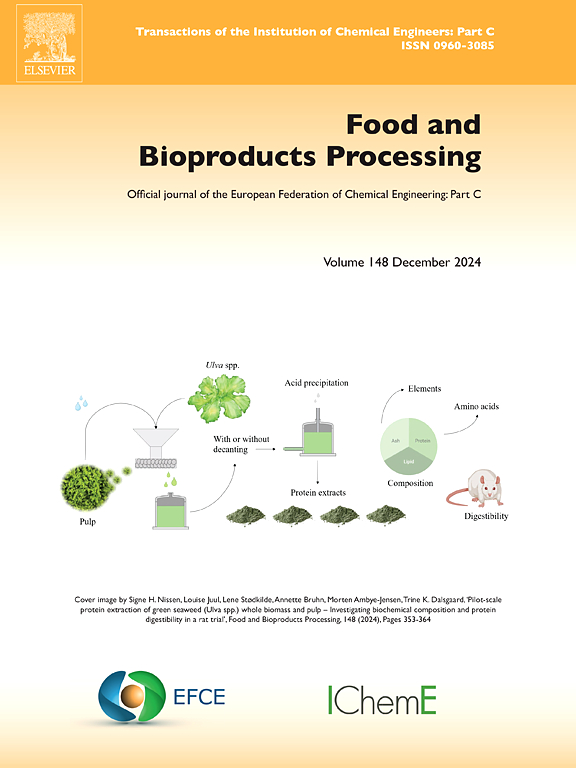Carbon and water footprints of the revalorisation of glucosinolates from broccoli by-products: Case study from Spain
IF 3.5
2区 农林科学
Q2 BIOTECHNOLOGY & APPLIED MICROBIOLOGY
引用次数: 0
Abstract
Assessing the costs, benefits, and externalities of circular economy measures from a life cycle perspective is increasingly important for developing sustainable agro-food strategies. This study evaluates the carbon and water implications of revalorising glucosinolates from broccoli by-products through two distinct life-cycle scenarios in a case study conducted in Navarra, Spain. In the first scenario, glucosinolates are obtained from conventional broccoli production, where they are naturally present in the edible inflorescences. The second scenario introduces an innovative step: extracting glucosinolates from otherwise discarded broccoli by-products, such as stalks and inflorescence detachments. Carbon and water footprints were analysed for both scenarios based on the production of 1000 grams of glucosinolates. The results reveal that while the second scenario enhances resource efficiency by utilizing agricultural waste, the environmental costs of the extraction process outweigh the benefits, leading to a 37.6 % increase in greenhouse gas emissions and a 4.6 % rise in water usage compared to the first scenario. To address this, an improvement scenario is proposed, featuring a more efficient use of solvents during extraction, which significantly reduces both emissions and water use. This study underscores that circular economy strategies in agro-food systems do not always translate into environmental benefits accross all resources. A detailed analysis of various carbon and water indicators has provided valuable insights to enhance the environmental performance of such strategies, reinforcing the importance of life-cycle assessments in shaping more effective agro-food policies.
从西兰花副产品中提取硫代葡萄糖苷的碳和水足迹:来自西班牙的案例研究
从生命周期角度评估循环经济措施的成本、效益和外部性,对于制定可持续农业食品战略越来越重要。本研究在西班牙纳瓦拉进行的一个案例研究中,通过两种不同的生命周期情景,评估了西兰花副产品硫代葡萄糖苷重定价对碳和水的影响。在第一种情况下,硫代葡萄糖苷从传统的西兰花生产中获得,它们自然存在于可食用的花序中。第二种方案引入了一个创新的步骤:从废弃的西兰花副产品中提取硫代葡萄糖苷,比如茎和花序。以生产1000 克硫代葡萄糖苷为基础,分析了两种情况下的碳足迹和水足迹。结果表明,虽然第二种情景通过利用农业废弃物提高了资源效率,但提取过程的环境成本超过了收益,导致温室气体排放量增加37.6% %,用水量增加4.6% %。为了解决这个问题,提出了一种改进方案,其特点是在提取过程中更有效地使用溶剂,从而显著减少排放和水的使用。这项研究强调,农业粮食系统中的循环经济战略并不总是转化为所有资源的环境效益。对各种碳和水指标的详细分析为提高此类战略的环境绩效提供了宝贵的见解,强调了生命周期评估在制定更有效的农业粮食政策方面的重要性。
本文章由计算机程序翻译,如有差异,请以英文原文为准。
求助全文
约1分钟内获得全文
求助全文
来源期刊

Food and Bioproducts Processing
工程技术-工程:化工
CiteScore
9.70
自引率
4.30%
发文量
115
审稿时长
24 days
期刊介绍:
Official Journal of the European Federation of Chemical Engineering:
Part C
FBP aims to be the principal international journal for publication of high quality, original papers in the branches of engineering and science dedicated to the safe processing of biological products. It is the only journal to exploit the synergy between biotechnology, bioprocessing and food engineering.
Papers showing how research results can be used in engineering design, and accounts of experimental or theoretical research work bringing new perspectives to established principles, highlighting unsolved problems or indicating directions for future research, are particularly welcome. Contributions that deal with new developments in equipment or processes and that can be given quantitative expression are encouraged. The journal is especially interested in papers that extend the boundaries of food and bioproducts processing.
The journal has a strong emphasis on the interface between engineering and food or bioproducts. Papers that are not likely to be published are those:
• Primarily concerned with food formulation
• That use experimental design techniques to obtain response surfaces but gain little insight from them
• That are empirical and ignore established mechanistic models, e.g., empirical drying curves
• That are primarily concerned about sensory evaluation and colour
• Concern the extraction, encapsulation and/or antioxidant activity of a specific biological material without providing insight that could be applied to a similar but different material,
• Containing only chemical analyses of biological materials.
 求助内容:
求助内容: 应助结果提醒方式:
应助结果提醒方式:


